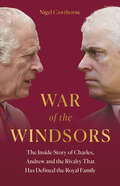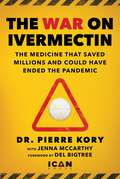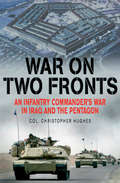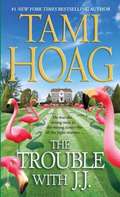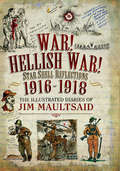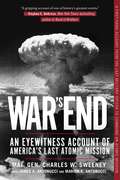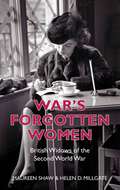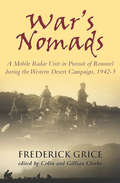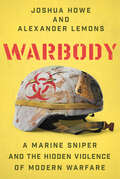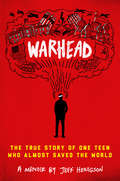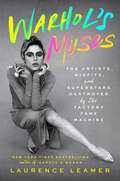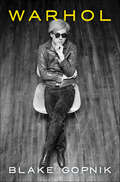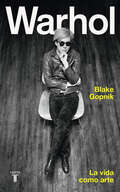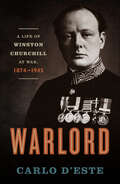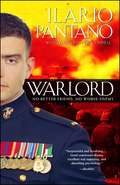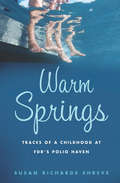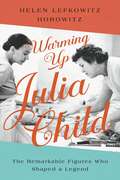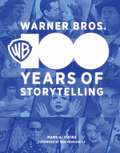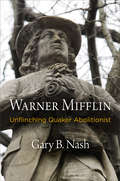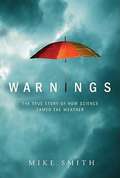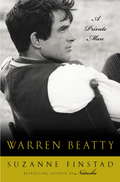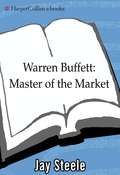- Table View
- List View
War of the Windsors: The Inside Story of Charles, Andrew and the Rivalry That Has Defined the Royal Family
by Nigel CawthorneTelling the story of their lives from children to modern day, this fascinating and revelatory new book will look at the fraught relationship (and fiery rivalry) between King Charles and Prince Andrew.Raised for vastly different futures, one burdened with the responsibility of becoming the future king and the other destined to live in his shadow, Charles and Andrew have spent their lives on different sides of the same coin.War of the Windsors tells, for the first time, the complete story of Charles and Andrew from their diverging childhoods to their current struggles. It looks at the distinct but overlapping stories of the two heirs, from being separated in their early years and the Queen's supposed overindulgence of Andrew to the competition for Lady Diana and finally, Charles' ascension to throne while his brother is stripped of Royal duties. And it explores whether, with the scandals around Andrew still fresh in public memory, Charles will ever let his brother back into the family.With extensive research and expert sourcing, War of the Windsors is the incredible inside story of a family in turmoil. Recounting the highs and lows of a brotherhood then turned into a rivalry, royal author and journalist Nigel Cawthorne looks at the makings of a decades long feud and questions whether, ultimately, the brothers will one day band together again.
War on Ivermectin: The Medicine that Saved Millions and Could Have Ended the Pandemic
by Pierre Kory Jenna McCarthyBig Pharma and health agencies cry, &“Don&’t take ivermectin!&” A media storm follows. Why then, does the science say the opposite?&” Ivermectin is a dirty word in the media. It doesn&’t work. It&’s a deadly horse dewormer. Prescribe or promote it and you&’ll be called a right-wing quack, be banned from social media, or lose your license to practice medicine. And yet, entire countries wiped out the virus with it, and more than ninety-five studies now show it to be unequivocally effective in preventing and treating Covid-19. If it didn&’t work, why was there a coordinated global campaign to cancel it? What&’s the truth about this decades-old, Nobel Prize-winning medication? The War on Ivermectin is the personal and professional narrative of Dr. Pierre Kory and his crusade to recommend a safe, inexpensive, generic medicine as the key to ending the pandemic. Written with Jenna McCarthy, Dr. Kory&’s story chronicles the personal attacks, professional setbacks, and nefarious efforts of the world&’s major health agencies and medical journals to dismiss and deny ivermectin&’s efficacy. Part personal narrative, part scathing expose, The War on Ivermectin highlights the catastrophic impacts of the mass media censorship and relentless propaganda that led to the greatest humanitarian crisis in history. Although numerous studies and epidemiologic data have shown that millions of lives were saved globally with the systematic use of ivermectin, many more millions perished. This carnage was the direct result of what Dr. Kory eventually discovered to be the pharmaceutical industry&’s silent but deadly war on generic medicines and the corrupt, captured medical and media systems that allow it to continue. For anyone who thought Covid-19 was the enemy, Dr. Kory&’s book will leave no doubt that the true adversary in this war is a collective cabal of power-hungry elites who put profits over people and will stop at nothing in their quest for control.The War on Ivermectin is published through ICAN PRESS, an imprint of Skyhorse Publishing. ICAN (Informed Consent Action Network) is a nonprofit organization investigating the safety of medical procedures, pharmaceutical drugs, and vaccines while advocating for people&’s right to informed consent.
War on Two Fronts: An Infantry Commander's War in Iraq and the Pentagon
by Col. Christopher HughesA vivid memoir of the conflict&’s early years combined with &“an insightful review of our problems in Iraq&” (Publishers Weekly). Winner of The Army Historical Foundation&’s Distinguished Writing Award. Shortly after the launch of Operation Iraqi Freedom, the war in Iraq became the most confusing in US history, the high command not knowing who to fight, who was attacking coalition troops, and who among the different Iraqi groups were fighting each other. Yet there were a few astute officers like Lt. Col. Christopher Hughes, commanding the 2nd Battalion of the 327th Infantry Regiment, 101st Airborne, who sensed the complexity of the task from the beginning. In War on Two Fronts, Lt. Col. Hughes writes movingly of his &“no-slack&” battalion at war in Iraq. The war got off to a bang for Hughes when his brigade command tent was fragged, leaving him briefly in charge of the brigade. Amid the nighttime confusion of fourteen casualties, a nearby Patriot missile blasted off, panicking nearly everyone while mistakenly bringing down a British Tornado fighter-bomber. As Hughes&’ battalion forged into Iraq, they successfully liberated the city of Najaf, securing the safety of Grand Ayatollah Sistani and the Mosque of Ali while showing an acute cultural awareness that caught the world&’s attention. It was a feat that landed Hughes within the pages of Time, Newsweek, and other publications. The Screaming Eagles of the 101st Airborne then implemented creative programs in the initial postwar occupation, including harvesting the national wheat and barley crops while combating nearly invisible insurgents. Conscious that an army battalion is a community of some seven-hundred-plus households, and that when a unit goes off to war, the families are intimately connected in our internet age, Hughes makes clear the strength of those connections and how morale is best supported at both ends. Transferred to Washington after his tour, Hughes also writes an illuminating account of the herculean efforts of many in the Pentagon to work around the corporatist elements of its bureaucracy in order to better understand counterinsurgency and national reconstruction, which Lawrence of Arabia described as &“like learning to eat soup with a knife.&” This book helps explain the sources of mistakes made—and the process needed to chart a successful strategy. Written with candor and no shortage of humor, mixed with brutal scenes of combat and frank analysis, it is a must-read for all who seek insight into our current situation in the Mideast.
War on the Run: The Epic Story of Robert Rogers and the Conquest of America’a First Frontier
by John F. RossRoss, executive editor of American Heritage magazine, has written this biography of American colonial frontiersman Robert Rogers to reveal how his observations of Native American warriors led to combat strategies that are still effective today. Written for general audiences, this book explains how Rogers trained and led an army of farmers, scouts and woodsmen on a series of military missions that are still considered impossible today. The author also explains how Rogers' 28 Rules of Engagement laid the groundwork for the Revolutionary War, and how his explorations of the frontier inspired the Lewis and Clark expedition. Annotation ©2009 Book News, Inc., Portland, OR (booknews.com)
War! Hellish War! Star Shell Reflections, 1916–1918: The Illustrated Diaries of Jim Maultsaid
by Barbara McCluneJim Maultsaid's illustrated diaries of his Great War service offer a unique and completely original perspective of a fighting mans experiences.Although an American citizen Jim was living in Donegal in 1914 and first joined the Young Citizens Volunteers and then the British Army. On 1 July 1916 the first day of the Somme, Sergeant Maultsaid was seriously wounded. To quote from his diary as he lay in no-mans-land The most awful cries rent the night air it was a shambles it was Hell with the lid off it was. Unlike so many, Jim survived and was hospitalised in Blighty. After a spell in Northern Ireland, he was selected for officer training at Cambridge. He was commissioned into The Chinese Labour Corps and his words and art work throw fascinating light on this little known but invaluable organization. Jims admiration for the CLCs contribution and culture is obvious.War! Hellish War! is more than a Great War diary it is a masterpiece and a collectors item of great historical and educational value. Despite the countless records of this conflict there is nothing to compare it with.
War's End: An Eyewitness Account of America's Last Atomic Mission
by Charles W. Sweeney James A. Antonucci Marion K. AntonucciOn August 9, 1945, on the tiny island of Tinian in the South Pacific, a twenty-five-year-old American Army Air Corps major named Charles W. Sweeney climbed aboard a B-29 Superfortress in command of his first combat mission, one devised specifically to bring a long and terrible war to a necessary conclusion. In the belly of his bomber, Bock's Car, was a newly developed, fully armed weapon that had never been tested in a combat situation. It was a weapon capable of a level of destruction never before dreamed of in the history of the human race, a bomb whose terrifying aftershock would ultimately determine the direction of the twentieth century and change the world forever. The last military officer to command an atomic mission, Major General Charles W. Sweeney has the unique distinction of having been an integral part of both the Hiroshima and the Nagasaki bombing runs. Now updated with a new epilogue from the co-author, his book is an extraordinary chronicle of the months of careful planning and training; the setbacks, secrecy, and snafus; and the nerve-shattering final seconds and the astonishing aftermath of what is arguably the most significant single event in modern history: the employment of an atomic weapon during wartime. The last military officer to command an atomic mission, Major General Charles W. Sweeney has the unique distinction of having been an integral part of both the Hiroshima and the Nagasaki bombing runs. His book is an extraordinary chronicle of the months of careful planning and training; the setbacks, secrecy, and snafus; and the nerve-shattering final seconds and the astonishing aftermath of what is arguably the most significant single event in modern history: the employment of an atomic weapon during wartime.
War's Forgotten Women: British Widows of the Second World War
by Helen D Millgate Maureen ShawThe Second World War widows were the ‘forgotten women’, largely ignored by the government and the majority of the population. The men who died in the service of their country were rightly honoured, but the widows and orphans they left behind were soon forgotten. During the war and afterwards in post-war austerity Britain their lives were particularly bleak. The meagre pensions they were given were taxed at the highest rate and gave them barely enough to keep body and soul together, let alone look after their children. Through their diaries, letters and personal interviews we are given an insight into post-war Britain that is a moving testament to the will to survive of a generation of women. The treatment of these war widows was shameful and continued right up to 1989. This is their story.
War's Nomads: A Mobile Radar Unit in Pursuit of Rommel during the Western Desert Campaign, 1942–3
by Frederick Grice&“The only known detailed account in existence of the small radar units who played a key part in the Western Desert Campaign . . . Highly recommended&” (Military Modelcraft International). War&’s Nomads is an evocative account of one man&’s experience of life in a mobile radar unit after the battle of El Alamein as Rommel&’s Afrika Korps was relentlessly pursued across the desert through Egypt, Libya, and Tunisia by the Eighth Army. After Fred Grice was called up in 1941, he kept two journals of his experiences. The first deals with waiting to embark after initial training, the journey to the battle zone, and the privations of a low-ranking AC. Daily life onboard a ship is vividly brought to life with details of routine, the cramped conditions, the banter and hobbies used to pass the time by the troops, and the luxurious-by-contrast existence of the officers. The second gives a detailed account of the activities of Unit 606, a radar crew that follows just behind the battlefront. 606 provided radio-detection for the advanced landing grounds being used by RAF fighter-bomber squadrons, because these landing strips, in turn, were the target of the German Luftwaffe and Italian Air Force attacks. It was a tiny unit, never more than ten men, frequently operating for protracted periods in complete isolation. Fred Grice&’s account lyrically evokes the landscape and the often tense and dangerous environment they operated in, pitching the reader into the experience of traveling with the unit in a three-ton truck, finding ingenious solutions to lack of rations and living space, even commandeering an abandoned boat to relax in the sea, while constantly needing to be alert to dodge air attacks. Along with these colorful first-person accounts, War&’s Nomads includes an authoritative introduction explaining the background to the military events of the Western Desert campaign, and the purpose of 606&’s mission, which Grice for security reasons could not talk about: to get to a selection of the two hundred or so landing grounds in the desert with all speed—and then defend them against air attack by using a light warning radar set developed to go operational within an hour.
Warbody: A Marine Sniper and the Hidden Violence of Modern Warfare
by Joshua Howe Alexander LemonsA friendship between an environmental historian and a chronically ill US Marine yields a powerful exploration into the toxic effects of war on the human body. Alexander Lemons is a Marine Corps scout sniper who, after serving multiple tours during the Iraq War, returned home seriously and mysteriously ill. Joshua Howe is an environmental historian who met Lemons as a student in one of his classes. Together they have crafted a vital book that challenges us to think beyond warfare’s acute violence of bullets and bombs to the “slow violence” of toxic exposure and lasting trauma. In alternating chapters, Lemons vividly describes his time in Fallujah and elsewhere during the worst of the Iraq War, his descent into a decade-long battle with mysterious and severe sickness, and his return to health; Howe explains, with clarity and scientific insight, the many toxicities to which Lemons was exposed and their potential consequences. Together they cover the whirlwind of toxic exposures military personnel face from the things they touch and breathe in all the time, including lead from bullets, jet fuel, fire retardants, pesticides, mercury, dust, and the cocktail of toxicants emitted by the open-air “burn pits” used in military settings to burn waste products like paint, human waste, metal cans, oil, and plastics. They also consider PTSD and traumatic brain injury, which are endemic among the military and cause and exacerbate all kinds of physical and mental health problems. Finally, they explore how both mainstream and alternative medicine struggle to understand, accommodate, and address the vast array of health problems among military veterans. Warbody challenges us to rethink the violence we associate with war and the way we help veterans recover. It is a powerful book with an urgent message for the nearly twenty million Americans who are active military or veterans, as well as for their families, their loved ones, and all of us who depend on their service.
Warhead: The True Story of One Teen Who Almost Saved the World
by Jeff HenigsonAn often hilarious and always relevant memoir about one teen boy's battle with brain cancer and his Starlight Children's Foundation wish: to meet Mikhail Gorbachev in Russia and plead for nuclear disarmament and world peace. <P><P>It's 1986, and Jeff is an average fifteen-year-old: he thinks a lot about dating, he bounces around with his friends, and he's trying his hardest to get a car. Conversely, the world around him feels crazy: the United States and the Soviet Union are at glaring odds, with their leaders in a standoff, and that awful word, "nuclear," is on everyone's mind. Then, boom--Jeff learns that he has brain cancer and it's likely terminal. Well, that puts a damper on his summer plans and romantic prospects, doesn't it?Jeff's family rallies around him, but they are fiercely complicated--especially Jeff's father, a man who can't say "I love you" even during the worst of Jeff's treatment. So when the Starlight Children's Foundation offers to grant Jeff a wish, he makes one certain to earn his father's respect: he asks to travel to Moscow and meet with Mikhail Gorbachev to discuss nuclear disarmament and ending the Cold War. Nothing like achieving world peace to impress a distant father, right? Jeff has always been one to aim high. <P><P>Jeff's story is dark, but it's also funny, romantic, and surprising. As his life swings from incredibly ordinary to absolutely incredible, he grapples with the big questions of mortality, war, love, hope, and miracles.
Warhol's Muses: The Artists, Misfits, and Superstars Destroyed by the Factory Fame Machine
by Laurence LeamerONE OF &“12 NEW NONFICTION BOOKS YOU NEED TO READ IN 2025&”—THE OBSERVERA &“MUST-READ&” BOOK OF SPRING 2025 – TOWN & COUNTRYONE OF &“25 BOOKS TO READ IN 2025&”—TORONTO STARFrom the New York Times bestselling author of Capote&’s Women comes an astonishing account of the revolutionary artist Andy Warhol and his scandalous relationships with the ten women he deemed his &“Superstars&”.&“Now and then, someone would accuse me of being evil,&” Andy Warhol confessed, &“of letting people destroy themselves while I watched, just so I could film them.&” Obsessed with celebrity, the silver-wigged artistic icon created an ever-evolving entourage of stunning women he dubbed his &“Superstars&”—Baby Jane Holzer, Edie Sedgwick, Nico, Ultra Violet, Viva, Brigid Berlin, Ingrid Superstar, International Velvet, Mary Woronov, and Candy Darling. He gave several of them new names and manipulated their beauty and talent for his art and social status with no regard for their safety, their dignity, or their lives.In Warhol&’s Muses, bestselling biographer Laurence Leamer shines a spotlight on the complex women who inspired and starred in Warhol&’s legendary underground films—The Chelsea Girls, The Nude Restaurant, and Blue Movie, among others. Drawn by the siren call of Manhattan life in the sixties, they each left their protected enclaves and ventured to a new world, Warhol&’s famed Factory, having no sense that they would never be able to return to their old homes and familiar ways again. Sex was casual, drugs were ubiquitous, parties were wild, and to Warhol, everyone was transient, temporary, and replaceable. It was a dangerous game he played with the women around him, and on a warm June day in 1968, someone entered the Factory and shot him, changing his life forever.Warhol&’s Muses explores the lives of ten endlessly intriguing women, transports us to a turbulent and transformative era, and uncovers the life and work of one of the most legendary artists of all time.
Warhol: A Life As Art
by Blake GopnikThe definitive biography of a fascinating and paradoxical figure, one of the most influential artists of his—or any—age To this day, mention the name “Andy Warhol” to almost anyone and you’ll hear about his famous images of soup cans and Marilyn Monroe. But though Pop Art became synonymous with Warhol’s name and dominated the public’s image of him, his life and work are infinitely more complex and multi-faceted than that. In Warhol, esteemed art critic Blake Gopnik takes on Andy Warhol in all his depth and dimensions. “The meanings of his art depend on the way he lived and who he was,” as Gopnik writes. “That’s why the details of his biography matter more than for almost any cultural figure,” from his working-class Pittsburgh upbringing as the child of immigrants to his early career in commercial art to his total immersion in the “performance” of being an artist, accompanied by global fame and stardom—and his attempted assassination. The extent and range of Warhol’s success, and his deliberate attempts to thwart his biographers, means that it hasn’t been easy to put together an accurate or complete image of him. But in this biography, unprecedented in its scope and detail as well as in its access to Warhol’s archives, Gopnik brings to life a figure who continues to fascinate because of his contradictions—he was known as sweet and caring to his loved ones but also a coldhearted manipulator; a deep-thinking avant-gardist but also a true lover of schlock and kitsch; a faithful churchgoer but also an eager sinner, skeptic, and cynic. Wide-ranging and immersive, Warhol gives us the most robust and intricate picture to date of a man and an artist who consistently defied easy categorization and whose life and work continue to profoundly affect our culture and society today.
Warhol: La vida como arte
by Blake Gopnik«Una biografía épica. Un libro para disfrutar, ameno y plagado de detalles. Fascinante».Kirkus Reviews Basada en años de investigación y entrevistas con decenas de amigos, amantes y detractores de Warhol, esta biografía traza el recorrido del artista desde sus orígenes como hijo de inmigrantes de Europa del Este en Pittsburgh hasta su revolucionario papel en el mundo del arte. Además, es un fascinante retrato de la sociedad y del mundo en los años setenta y ochenta y de las grandes transformaciones ocurridas en el comercio y la cultura. Tras el resplandor de su famosa Factory, por donde pasaron las figuras más glamurosas de su tiempo (Susan Sontag, Mick Jagger o los barones de Rothschild, entre otros), había un hombre tímido que vivió gran parte de su vida con su madre y protegió con celo su privacidad. Repleto de ideas nuevas sobre el trabajo y la personalidad del artista, este libro capta a la perfección las contradicciones y el radical ingenio que llevaron a Warhol a revolucionar el panorama cultural. ¿Era una broma o un auténtico genio? ¿Era un radical o un arribista? Como el propio Warhol habría respondido: sí. La crítica ha dicho:«Ojalá hubiese podido conocer mejor a Warhol. Esta fantástica biografía me hace sentir que así fue. Revela tanto al hombre como al genio que se encuentran bajo esa peluca plateada».ELTON JOHN «Hay tantos momentos warholianos en este magnífico libro que no sabría por dónde empezar. Cautivador, tiene tanto de historia del arte y filosofía como de biografía».The Guardian «Warhol vivió una de las más grandiosas vidas del siglo XX y ahora cuenta con una biografía a la altura de esa vida. No le sobra ni una página».Los Angeles Times «Absorbente».The Wall Street Journal «Impresionante, arrebatador».Washington Post «Fantástica y minuciosa. El autor indaga en la vida de uno de los mayores mitos de nuestros tiempos, con peluca plateada incluida».The Evening Standard «Una épica biografía del rey del pop art. Un libro para disfrutar, que aporta todo lujo de detalles con una escritura ágil. Fascinante».Kirkus Reviews «La más biografía más completa y lúcida de Warhol. El autor navega a través de la amplia documentación sin empantanarse, y defiende a Warhol como un genio hecho a sí mismo».Apollo Magazine «Una excelente mirada a la vida, la personalidad y el genio de Andy».Diane Von Furstenberg
Warlord: A Life of Winston Churchill at War, 1874–1945
by Carlo D'EsteAs riveting as the man it portrays, Warlord is a masterful, unsparing portrait of Winston Churchill, one of history’s most fascinating and influential leaders. “Epic. . . . A brilliantly exciting narrative. . . . D’Este has given us, finally, the lion not only in winter, but at war: impetuous, brazen, misguided, but indefatigable, indomitable, and magnanimous: the greatest and most energetic generalissimo of the 20th century.” —Boston GlobeCarlo D’Este’s definitive chronicle of Churchill’s crucial role in the major military campaigns of the 20th century, Warlord uses extensive, untapped archival materials to provide “a very human look at Churchill’s lifelong fascination with soldiering, war, and command.” (Washington Post)
Warlord: Broken by War, Saved by Grace
by Malcolm Mcconnell Ilario PantanoThis is the powerful true story of the Marine lieutenant who, having fought for his country in the first Gulf War, went on to professional success in finance, only to be compelled to reenlist in the wake of 9/11. Leaving behind an ex-model wife and two children, he served once again in Iraq -- and was charged by the U.S. military with murder. Ilario Pantano has always been a warrior at heart -- it's the force that drives him, that defines his core being and his life. But on April 15, 2004, just a few moments during the most violent and chaotic month in the Iraq War would change his life forever. On a raid in the Sunni hotbed of the Al Anbar province, Lieutenant Pantano shot and killed two Iraqi insurgents. Months later, while successfully leading Marines during the explosive surge in terrorist activity, including the battles for Fallujah, one of his own men disputed Pantano's self-defense claim in the Al Anbar shootings. Pantano was relieved of his command and charged with premeditated murder, a crime punishable by death. Now for the first time, in his own words, Pantano recounts his gripping and controversial story in Warlord, the memoir of a patriot who prepared to reenlist as the Twin Towers fell on September 11, 2001, ten years after his service as an elite Marine sniper and veteran of Desert Storm. Warlord is the story of an unconventional fighter who combined his professional and military experiences to protect the lives of his men and win both on battlefields and in the courtroom. In the face of a widely publicized military hearing, Pantano's family "attacked into the ambush," launching a Defend-the-Defenders campaign that was met with overwhelming support nationwide. Pantano was cleared of all charges. But most surprising of all, the heart of the patriot has not been embittered as he calls on his fellow Americans to stand strong in the face of our enemies. A harrowing, redemptive, and singular contribution to the literature of war, Ilario Pantano's inspiring story brings an unrivaled human dimension to the conflict in Iraq, to the unyielding idealism that drives its American fighting men and women, and to the unexpected consequences and uncompromised faith that can emerge from the brutal, chaotic, and irreversible nature of combat.
Warlords, Strongman Governors, and the State in Afghanistan
by Dipali MukhopadhyayWarlords have come to represent enemies of peace, security, and 'good governance' in the collective intellectual imagination. This book asserts that not all warlords are created equal. Under certain conditions, some become effective governors on behalf of the state. This provocative argument is based on extensive fieldwork in Afghanistan, where Mukhopadhyay examined warlord-governors who have served as valuable exponents of the Karzai regime in its struggle to assert control over key segments of the countryside. She explores the complex ecosystems that came to constitute provincial political life after 2001 and exposes the rise of 'strongman' governance in two provinces. While this brand of governance falls far short of international expectations, its emergence reflects the reassertion of the Afghan state in material and symbolic terms that deserve our attention. This book pushes past canonical views of warlordism and state building to consider the logic of the weak state as it has arisen in challenging, conflict-ridden societies like Afghanistan.
Warm Springs: Traces of a Childhood at FDR's Polio Haven
by Susan Richards ShreveJust after her eleventh birthday, Susan Richards Shreve was sent to the sanitarium at Warm Springs, Georgia. The polio haven, famously founded by FDR, was "a perfect setting in time and place and strangeness for a hospital of crippled children." During Shreve's two year stay, the Salk vaccine would be discovered, ensuring that she would be among the last Americans to have suffered childhood polio. At Warm Springs, Shreve found herself in a community of similarly afflicted children, and for the first time she was one of the gang. Away from her fiercely protective mother, she became a feisty troublemaker and an outspoken ringleader. Shreve experienced first love with a thirteen-year-old boy in a wheelchair. She navigated rocky friendships, religious questions, and family tensions, and encountered healing of all kinds. Shreve's memoir is both a fascinating historical record of that time and an intensely felt story of childhood.
Warming Up Julia Child: The Remarkable Figures Who Shaped a Legend
by Helen Lefkowitz HorowitzA Pulitzer prize-finalist peels back the curtain on an unexplored part of Julia Child's life—the formidable team of six she collaborated with to shape her legendary career.
Warmth: Coming of Age at the End of Our World
by Daniel SherrellFrom a millennial climate activist, an exploration of how young people live in the shadow of catastrophe&“Strikingly perceptive.&” —Jenny Offill, author of Weather &“Beautifully rendered and bracingly honest.&” —Jenny Odell, author of How to Do NothingWarmth is a new kind of book about climate change: not what it is or how we solve it, but how it feels to imagine a future--and a family--under its weight. In a fiercely personal account written from inside the climate movement, Sherrell lays bare how the crisis is transforming our relationships to time, to hope, and to each other. At once a memoir, a love letter, and an electric work of criticism, Warmth goes to the heart of the defining question of our time: how do we go on in a world that may not?
Warner Bros.: 100 Years of Storytelling
by Mark A. VieiraIn this official centennial history of the greatest studio in Hollywood, unforgettable stars, untold stories, and rare images from the Warner Bros. vault bring a century of entertainment to vivid life.The history of Warner Bros. is not just the tale of a legendary film studio and its stars, but of classic Hollywood itself, as well as a portrait of America in the last century. It&’s a family story of Polish-Jewish immigrants—the brothers Warner—who took advantage of new opportunities in the burgeoning film industry at a time when four mavericks could invent ways of operating, of warding off government regulation, and of keeping audiences coming back for more during some of the nation's darkest days. Innovation was key to their early success. Four years after its founding, the studio revolutionized moviemaking by introducing sound in The Jazz Singer (1927). Stars and stories gave Warner Bros. its distinct identity as the studio where tough guys like Humphrey Bogart and strong women like Bette Davis kept people on the edge of their seats. Over the years, these acclaimed actors and countless others made magic on WB&’s soundstages and were responsible for such diverse classics as Casablanca, A Streetcar Named Desire, A Star Is Born, Bonnie & Clyde, Malcolm X, Caddyshack, Purple Rain, and hundreds more. It&’s the studio that put noir in film with The Maltese Falcon and other classics of the genre, where the iconic Looney Tunes were unleashed on animation, and the studio that took an unpopular stance at the start of World War II by producing anti-Nazi films. Counter-culture hits like A Clockwork Orange and The Exorcist carried the studio through the 1970s and '80s. Franchise phenomena like Harry Potter, the DC universe, and more continue to shape a cinematic vision and longevity that is unparalleled in the annals of film history. These stories and more are chronicled in this comprehensive and stunning volume. Copyright © 2023 Warner Bros. Entertainment Inc.
Warner Bros: The Making of an American Movie Studio
by David ThomsonBehind the scenes at the legendary Warner Brothers film studio, where four immigrant brothers transformed themselves into the moguls and masters of American fantasyWarner Bros charts the rise of an unpromising film studio from its shaky beginnings in the early twentieth century through its ascent to the pinnacle of Hollywood influence and popularity. The Warner Brothers—Harry, Albert, Sam, and Jack—arrived in America as unschooled Jewish immigrants, yet they founded a studio that became the smartest, toughest, and most radical in all of Hollywood. David Thomson provides fascinating and original interpretations of Warner Brothers pictures from the pioneering talkie The Jazz Singer through black-and-white musicals, gangster movies, and such dramatic romances as Casablanca, East of Eden, and Bonnie and Clyde. He recounts the storied exploits of the studio’s larger-than-life stars, among them Al Jolson, James Cagney, Bette Davis, Errol Flynn, Humphrey Bogart, James Dean, Doris Day, and Bugs Bunny. The Warner brothers’ cultural impact was so profound, Thomson writes, that their studio became “one of the enterprises that helped us see there might be an American dream out there.”
Warner Mifflin: Unflinching Quaker Abolitionist
by Gary B. NashWarner Mifflin—energetic, uncompromising, and reviled—was the key figure connecting the abolitionist movements before and after the American Revolution. A descendant of one of the pioneering families of William Penn's "Holy Experiment," Mifflin upheld the Quaker pacifist doctrine, carrying the peace testimony to Generals Howe and Washington across the blood-soaked Germantown battlefield and traveling several thousand miles by horse up and down the Atlantic seaboard to stiffen the spines of the beleaguered Quakers, harried and exiled for their neutrality during the war for independence. Mifflin was also a pioneer of slave reparations, championing the radical idea that after their liberation, Africans in America were entitled to cash payments and land or shared crop arrangements. Preaching "restitution," Mifflin led the way in making Kent County, Delaware, a center of reparationist doctrine.After the war, Mifflin became the premier legislative lobbyist of his generation, introducing methods of reaching state and national legislators to promote antislavery action. Detesting his repeated exercise of the right of petition and hating his argument that an all-seeing and affronted God would punish Americans for "national sins," many Southerners believed Mifflin was the most dangerous man in America—"a meddling fanatic" who stirred the embers of sectionalism after the ratification of the Constitution of 1787. Yet he inspired those who believed that the United States had betrayed its founding principles of natural and inalienable rights by allowing the cancer of slavery and the dispossession of Indian lands to continue in the 1790s.Writing in beautiful prose and marshaling fascinating evidence, Gary B. Nash constructs a convincing case that Mifflin belongs in the Quaker antislavery pantheon with William Southeby, Benjamin Lay, John Woolman, and Anthony Benezet.
Warnings: The True Story of how Science tamed the Weather
by Mike SmithExperience the most devastating storms of the last fifty years through the eyes of the scientific visionaries who took them on and tamed them. Science and politics collide in this thrilling account of America's struggle for protection against the deadly threat of violent weather. Warnings tells the dramatic true stories of the unsung weather warriors who save innocent lives, often by risking their own.
Warren Beatty: A Private Man
by Suzanne Finstad"Whatever you have read or heard about me through articles or gossip, forget it. I am nothing like that Warren Beatty. I am nothing like what you have read." --Warren Beatty. Warren Beatty guarded his privacy even before he became a movie star, when he burst onto the screen in 1961 as the earnestly handsome all-American boy in Splendor in the Grass. When he started acting, Beatty kept secret the fact that actress Shirley MacLaine, already a star, was his older sister. Over time, he has cultivated a mystique, giving few interviews and instructing others not to talk about him. Until now. Through years of groundbreaking research, lauded biographer Suzanne Finstad gained unprecedented access to Beatty's family, close friends, and film colleagues, including such luminaries in the arts and politics as Jane Fonda, Goldie Hawn, Leslie Caron, Robert Towne, Mike Nichols, and Senators John McCain, George McGovern, and Gary Hart. Weaving hundreds of these candid interviews, photographs from private albums, personal letters, diaries, and the previously unpublished papers of the late Natalie Wood and mentors such as directors Elia Kazan and George Stevens, playwrights Clifford Odets and William Inge, and agent Charles Feldman, Warren Beatty unveils the real Beatty--a complex, sensitive visionary torn between the "fairly puritanical, football-playing boy" from Virginia and his Hollywood playboy image. Finstad paints a rich, fascinating portrait of the secretive film legend, taking us back to the "unrealized genius" parents who molded arguably the most famous brother and sister in Hollywood history, tracing the family influences and events in Beatty's past that directly inspired McCabe & Mrs. Miller, Shampoo, Heaven Can Wait, Reds, Ishtar, Dick Tracy, Bugsy, Love Affair, and Bulworth, and led to his political activism, culminating in a near-bid for the White House. Finstad constructs the definitive, myth-shattering account of Beatty's evolution from Hollywood's enfant terrible to producer of the revolutionary Bonnie and Clyde, launching him as the premier actor/director/writer/producer of his generation, the only person to twice earn Oscar nominations in all five major categories. Here also is the truth about Beatty the lover, setting the record straight on his storied relationships with such iconic actresses and beauties as Jane Fonda, Joan Collins, Natalie Wood, Leslie Caron, Julie Christie, Goldie Hawn, Michelle Phillips, Diane Keaton, Isabelle Adjani, and Madonna. Finstad's astute insights illuminate Beatty's private struggle to attain happiness, his complicated bond with his sister, Shirley, and the deeper reasons why, at fifty-four, the archetypal bachelor married actress Annette Bening. Stunningly researched, engrossing, and exquisitely detailed, Warren Beatty: A Private Man gives us a new understanding of the enigmatic, fiercely intelligent star who embodies the American dream.
Warren Buffett
by Jay SteeleWarren Buffett is known as the billionaire investment expert of the century and everyone would love to know the secret of his success. In his own words, Buffett is just a regular guy who likes fast food, honest work, and people he can trust. Throw in incredible instincts, a genius for numbers, meticulous research, and an almost sure-fire investment philosophy, and you begin to understand how he's become a legend in his own time. With just a few thousands of dollars from relatives and friends, and by taking calculated risks with small companies and staying with them, he managed, almost single-handedly, to turn Salomon Brothers around. Giants like Disney, American Express, McDonald's, Gillette, and Coca-Cola have all been affected by Buffett's magic touch, and he owns a chunk of all of them. By thirty-one, BUffett had already made himself a millionaire, and he's worked his way steadily toward the top of the Forbes list. Here is a fascinating portrait of Warren Buffett, known for his investigating genius, his sense of humor, and his mean turn of a phrase. It's an amazing story of a man who carved his own path through American business by doing his homework, backing companies he believed in, and growing rich on their success-a story that will show you that opportunity abounds for anyone willing to go for it.
